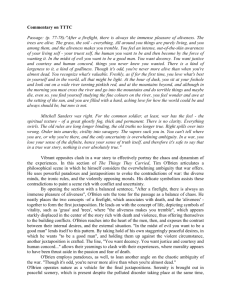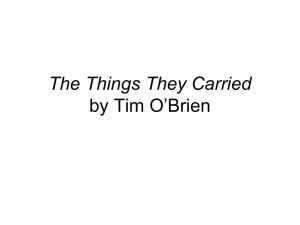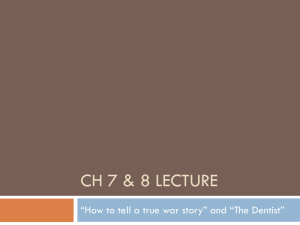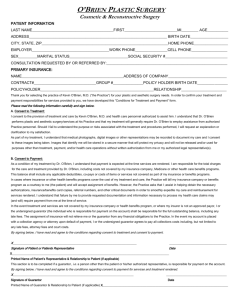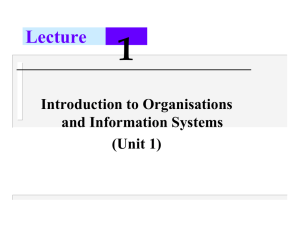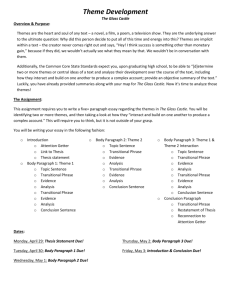The Things They Carried: Questions & Answers
advertisement
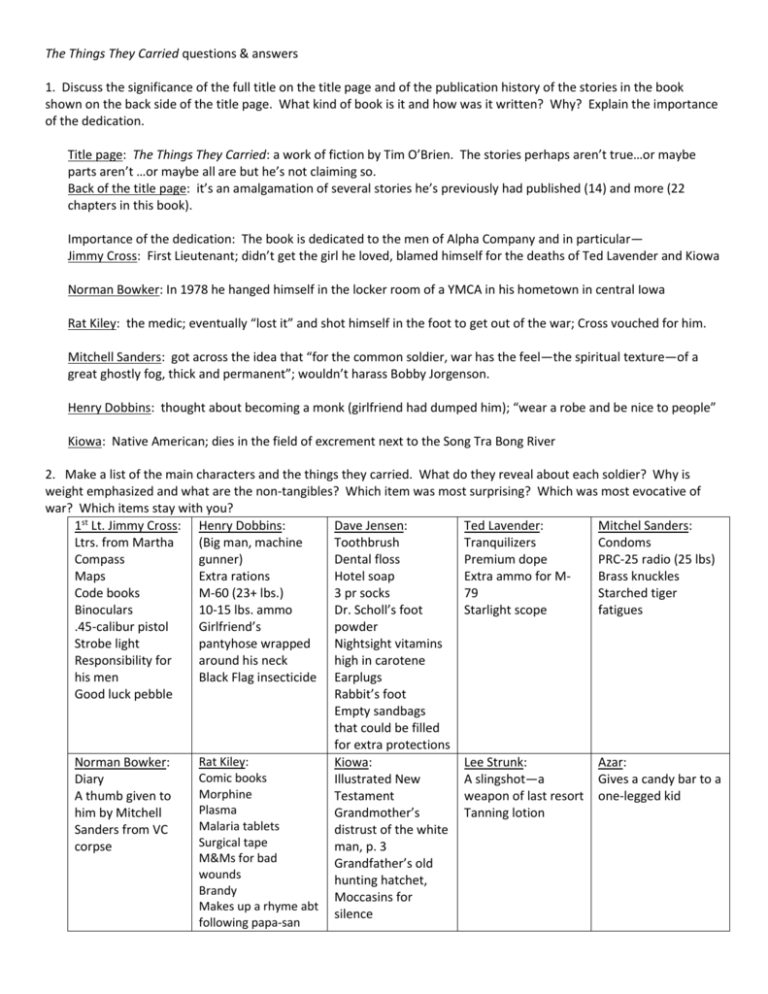
The Things They Carried questions & answers 1. Discuss the significance of the full title on the title page and of the publication history of the stories in the book shown on the back side of the title page. What kind of book is it and how was it written? Why? Explain the importance of the dedication. Title page: The Things They Carried: a work of fiction by Tim O’Brien. The stories perhaps aren’t true…or maybe parts aren’t …or maybe all are but he’s not claiming so. Back of the title page: it’s an amalgamation of several stories he’s previously had published (14) and more (22 chapters in this book). Importance of the dedication: The book is dedicated to the men of Alpha Company and in particular— Jimmy Cross: First Lieutenant; didn’t get the girl he loved, blamed himself for the deaths of Ted Lavender and Kiowa Norman Bowker: In 1978 he hanged himself in the locker room of a YMCA in his hometown in central Iowa Rat Kiley: the medic; eventually “lost it” and shot himself in the foot to get out of the war; Cross vouched for him. Mitchell Sanders: got across the idea that “for the common soldier, war has the feel—the spiritual texture—of a great ghostly fog, thick and permanent”; wouldn’t harass Bobby Jorgenson. Henry Dobbins: thought about becoming a monk (girlfriend had dumped him); “wear a robe and be nice to people” Kiowa: Native American; dies in the field of excrement next to the Song Tra Bong River 2. Make a list of the main characters and the things they carried. What do they reveal about each soldier? Why is weight emphasized and what are the non-tangibles? Which item was most surprising? Which was most evocative of war? Which items stay with you? 1st Lt. Jimmy Cross: Henry Dobbins: Dave Jensen: Ted Lavender: Mitchel Sanders: Ltrs. from Martha (Big man, machine Toothbrush Tranquilizers Condoms Compass gunner) Dental floss Premium dope PRC-25 radio (25 lbs) Maps Extra rations Hotel soap Extra ammo for MBrass knuckles Code books M-60 (23+ lbs.) 3 pr socks 79 Starched tiger Binoculars 10-15 lbs. ammo Dr. Scholl’s foot Starlight scope fatigues .45-calibur pistol Girlfriend’s powder Strobe light pantyhose wrapped Nightsight vitamins Responsibility for around his neck high in carotene his men Black Flag insecticide Earplugs Good luck pebble Rabbit’s foot Empty sandbags that could be filled for extra protections Rat Kiley: Norman Bowker: Kiowa: Lee Strunk: Azar: Comic books Diary Illustrated New A slingshot—a Gives a candy bar to a Morphine A thumb given to Testament weapon of last resort one-legged kid Plasma him by Mitchell Grandmother’s Tanning lotion Malaria tablets Sanders from VC distrust of the white Surgical tape corpse man, p. 3 M&Ms for bad Grandfather’s old wounds hunting hatchet, Brandy Moccasins for Makes up a rhyme abt silence following papa-san The things they all carried: Steel helmets: 5 lbs, p2 Flak jacket: 6.7 lbs, p3 At least one large compress bandage, p3 Green plastic poncho: 2 lbs, p3 Photographs M-16 gas-operated assault rifle + 12-20 magazines + maintenance gear Some carried M-79 grenade launcher + ammo Standard weapons=M-60, M-16, M-79 Fragmentation grenades, smoke grenades, tear gas grenades, phosphorous grenades A silent awe for the terrible power of the things they carried Mosquito netting, machetes, canvas tarps, extra bug juice, p9 Took turns carrying a 28-lb. mine detector Ghosts, p10 Explosives, p10 USO stationery, pencils, pens Long list of stuff on p14 Took turns carrying heavy radio They shared the weight of memory They carried each other Infections, diseases, malaria, dysentery, p14 Chess sets, basketballs, dictionaries, insignias of rank Lice, ringworm, leeches, paddy algae, various rots & molds They carried the land itself, the soil The sky, gravity, p 15 They carried all the emotional baggage of men who might die. The intangibles had their own mass and specific gravity, they had tangible weight, p21 3. Discuss the structure of the book. Do the stories progress in a linear manner? How does the book’s style contribute to its themes? The stories do not progress in a linear manner; rather, they “jump around” chronologically. Whatever theme O’Brien is presenting at the time predominates. This is how memory operates. After soldiers return home from war, they often suffer from flashbacks. 4. Why does Lt. Cross burn the letters and photographs? How does he change and is it a good or bad change? Cross burns the letters because Lavender has been killed. Cross emotionally breaks down in front of his men, which is a bad thing because it unnerves them. By burning the letters, Cross is probably trying to repress his connections to home. Perhaps he believes that, if he is 100% focused on being a professional soldier and leader to his men, he can save their lives. 5. Describe the element of suspense in searching the tunnels. How might this be a metaphor? Describe in detail your reaction to it as a reader. pp. 11-12: going in with a .45—drawing straws to decide who has to do it—17 men in group, Dobbins exempt because of his size—scary. The tunnel could cave in, VC could be in it. Rats, snakes, etc. The tunnel is a metaphor for the unknown, danger, death by bite, bullet, suffocation, etc. The whole experience is unnerving. 6. Explain the passage about death on p. 19. They’re young. When caught in a firefight, they are scared to their very cores. They move in and out of the illusion of being in control. 7. Why is the first story written in their person? What effect did it have when O’Brien switched to first person in the second chapter? Third person allows O’Brien to describe the men of Alpha Company from a distance. Switching to first person in the next chapter—giving intimate details of a first-hand account--gives O’Brien more credibility. This storytelling tactic also contributes to his overall message about the nature of the truth: there are multiple perspectives of any situation, and they are all valid. 8. On p. 29 we read about “me.” Who is this? (Actually, the pronoun I find on p. 29 is “I.”) “Me” is Tim O’Brien; he is named on p. 36. 9. If “On the Rainy River” is the moral center of the book, why is Elroy Berdahl O’Brien’s hero? Explain what Berdahl does and how and why. Discuss its implications for today. Is O’Brien a coward (p. 61)? Why or why not? Elroy Berdahl is O’Brien’s hero for being a smart, patient old man who judged O’Brien wisely, gave him the opportunity to escape to Canada (which was shy O’Brien headed north), and saw him through the personal agony O’Brien faced by making his decision to return to his home in Minnesota (didn’t want to shame himself, his relatives, his hometown). Elroy Berdahl left him with $200 for an “emergency fund,” which O’Brien left on his counter. Berdahl gave O’Brien odd jobs to do, prepared meals for him, and played Scrabble with him. Berdahl spoke little but wisely. O’Brien says he’s a coward for going to the war. Dodging the draft—and in the process failing to meet the expectations of family and society—carried its own burdens. Draft dodgers left their families behind. On the other hand, going to war has always required courage. Vietnam had its own particular kind of emotional conflict as the war became more futile and the American public disapproved of some of the things they heard about, such as the My Lai massacre. 10. Read pp. 42-43 (summer of 1968) and then read pp. 78-80. What connections do you see? Expand them. pp. 42-43: O’Brien worked in the Armour meatpacking plant as a Declotter. The meatpacking plant slaughters pigs. pp. 78-80: Rat Kiley tortures a baby water buffalo. Earlier in the day, Rat had been playing catch with Curt Lemon, when Curt stepped on a land mine and was blown to pieces. We have to assume that Rat is venting his own frustration when he tortures the buffalo. After doing so, he broke down crying. When is it OK to kill innocent animals? Is it OK if the animals are serving as a food source for people? Is it OK if they are serving as the “punching bag” for a stressed-out soldier? 11. What do you make of O’Brien’s definition of “truth” in “How to Tell a True War Story”? What are the qualities of a true war story, according to O’Brien? Which of the stories that are told in this story qualify and which don’t? pp. 68-69: A true war story is never moral. It does not instruct, nor encourage virtue, nor suggest models of proper human behavior, nor restrain men from doing the things men have always done. If a story seems moral, do not believe. If at the end of a war story you feel uplifted, or if you feel that some small bit of rectitude has been salvaged from the larger waste, then you have been made the victim of a very old and terrible lie. There is no rectitude whatsoever. There is no virtue. As a first rule of thumb, therefore, you can tell a true war story by its avsolute and uncompromising allegiance to obscenity and evil. This definition reminds me that the truth is very complex. It reminds me of the old adage, “Never judge a man until you have walked a mile in his shoes.” The truth has to always respect the experience of each and every individual. 12. How many times are we told the story of Curt Lemon’s death? What are the differences in the way the story is told? Explain the last paragraph of this story. This story is told at least seven times: 1. p. 32: first mention 2. p. 69-71: grenade goes off when two guys are goofing around 3. p. 78: Curt stepped on a booby-trapped 105 round when he and Rat were playing catch with a grenade 4. pp. 82-83: again, the grenade going off and Curt Lemon’s body parts hanging in the tree. Tim O’Brien and Dave Jensen ordered to get him down. 5. p. 84: O’Brien still sees sunlight on Lemon’s face. 6. p. 86: When Curt Lemon was killed, O’Brien found it hard to mourn. 7. pp. 87-88: Lemon hated dentists—fainted—but went back to the dentist to get a tooth pulled (it was a perfectly good tooth). He had to “save face” with his fellow soldiers. 13. Read pp. 80-82 (beginning with “How do you generalize?”) These are O’Brien’s generalizations about war and how it can be experienced. Can you related to any of this? If so, to what parts of your life do these comments connect? (See also p. 207 about movies and clichés.) This section speaks to me about losing my perspective during times of stress. 14. Mary Anne, “the sweetheart of Song Tra Bong” is obviously an emblematic character. What is O’Brien doing with her? Is this story believable? O’Brien is pushing our “suspension of disbelief” with Mary Anne, promoting every G.I.’s desire to be able to ship his woman to the front and then showing how that could be a disaster for him and her. It’s a fairly believable story until Mary Anne joins the “greenies,” the Green Berets. I’ve heard O’Brien admit in an interview that this chapter is very similar to Conrad’s The Heart of Darkness. O’Brien also said he was trying to include a female perspective in the book. 15. Who tells the story in “The Man I Killed”? This is not a simple question. The answer could be any G.I. It could be O’Brien’s conscience. The answer could be that, by imagining this VC’s life, O’Brien has given him voice and allowed the dead man to tell his own story. (This last one is the one I prefer.) 16. Linda, Tim’s “first date” (in “The Lives of the Dead”) is another emblematic character. What do you make of her? What does she represent in the novel? Linda represents death on the home front, dreams snuffed out, yet kept alive in one’s dream world, or story world. 17. Read “Notes” (pp. 155-161) and “Good Form” (pp. 179-180) and tell why O’Brien wrote this book. When he casts doubt on the veracity of the novel, does it make you more or less interested? Does it increase or decrease your understanding? What is the difference between “happening-truth” and “story-truth”? O’Brien wrote the book to “make good on Norman Bowker’s silence”—to tell a better story. To “make things present…look at things never looked at…attach faces to grief and love and pity and God…to be brave…to make [oneself] feel again.” Karen says, I am more interested when he casts doubt on the novel’s veracity. It might decrease my understanding some, though. O’Brien’s explanation of happening truth and story truth is on p. 180. Also see p. 158, about making up details to help the story make sense. It seems to me that the happening truth is briefer—it’s just the facts, just the what. The story truth includes more of the heart and emotion, more of the why. 18. How do the different accounts of Kiowa’s death relate to memory, storytelling, and truth? Why does O’Brien often tell us beforehand whether a story will have a happy or tragic ending? How does it affect your attitude toward the narrator? Norman Bowker, who almost got the Silver Star, grabs Kiowa’s body, maybe saving him in the excrement field when the mortar rounds were shot and hit Kiowa—but Kiowa slips away. Lt. Cross orders men to find Kiowa’s body. pp. 162-173. The young soldier who showed his girl’s picture to Kiowa who said, “Hey, she’s cute!” via a light right before the mortar hits. O’Brien often tells us beforehand whether a story will have a happy or tragic ending so that we can be more effective observers. We already know what’s coming. We can pay attention more to how the storyteller gets to the conclusion. This approach might make the reader more observant, more appreciative of a story well-told. 19. In “In the Field” (pp. 162-178), O’Brien writes, “When a man died, there had to be blame.” What does this mandate do the men of O’Brien’s company? Are they justified in thinking themselves at fault? How do they cope with their own feelings of culpability? O’Brien and the men of his company, especially the Lieutenant, evaluate their own level of being at fault, and as Norman Bowker said, “Nobody’s fault. Everybody’s.” Are they justified in thinking themselves at fault? Who’s to know for sure? See paragraph on p. 177. How do they cope with their own feelings of culpability? Norman Bowker eventually hangs himself. Henry Dobbins might become a monk. Tim O’Brien writes of the experiences of war. 20. Does your opinion of O’Brien change throughout the course of the novel? How so? How do you feel about his actions in “The Ghost Soldiers” (pp. 189-218)? Karen: My opinion of him doesn’t really change. O’Brien is a brave man to admit the things that he admits in this book (wanting to escape to Canada, but doesn’t, and then says he was a coward for not doing so). “The Ghost Soldiers” tells of O’Brien getting even with Jorgenson. This revenge story is not admirable, and I don’t approve of it any more than I approved of Rat Kiley killing the water buffalo, but again, I realize the soldiers needed emotional release valves, and I am very, very hesitant to pass judgment on them. Karen: He didn’t tell the ending ahead of time here because not being one of Alpha Company anymore had to be told as an outsider. The ending of the story is powerful, and revealing it ahead of time would have been a let-down.
